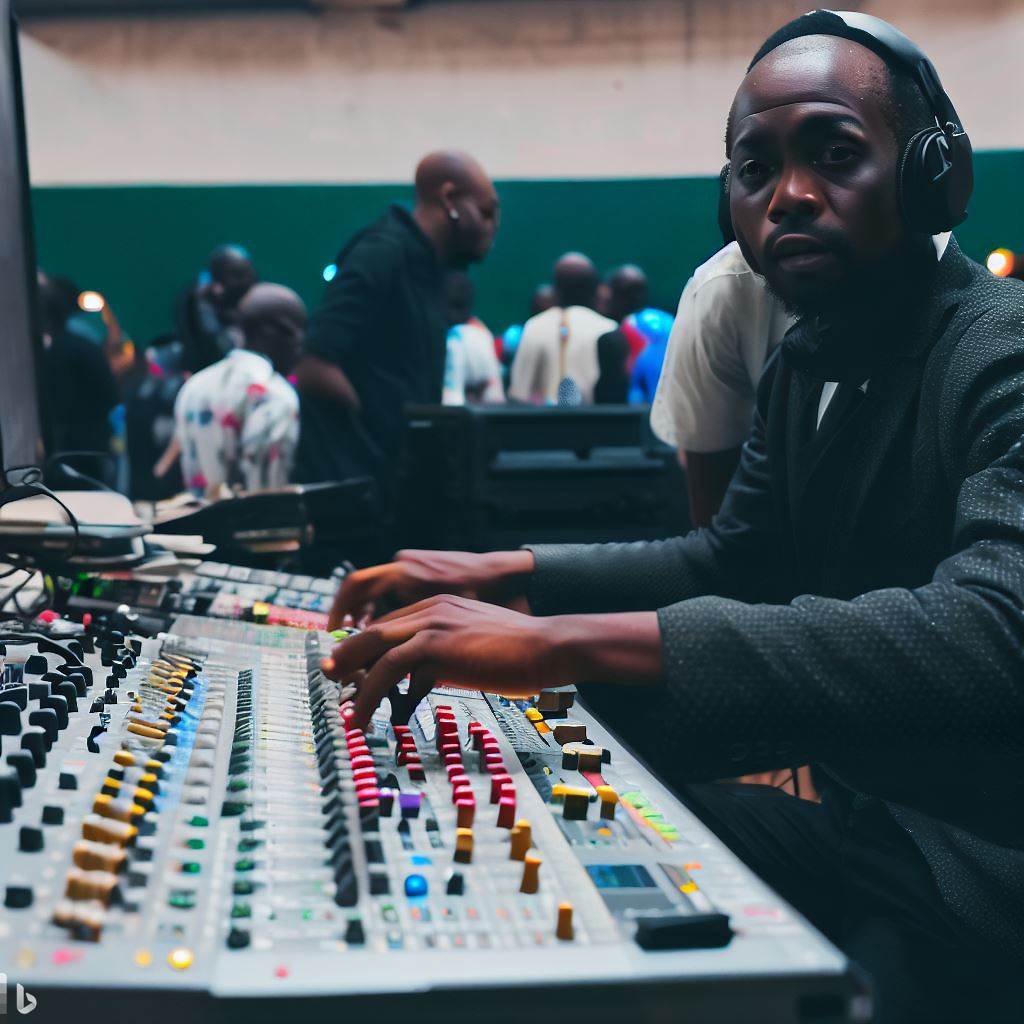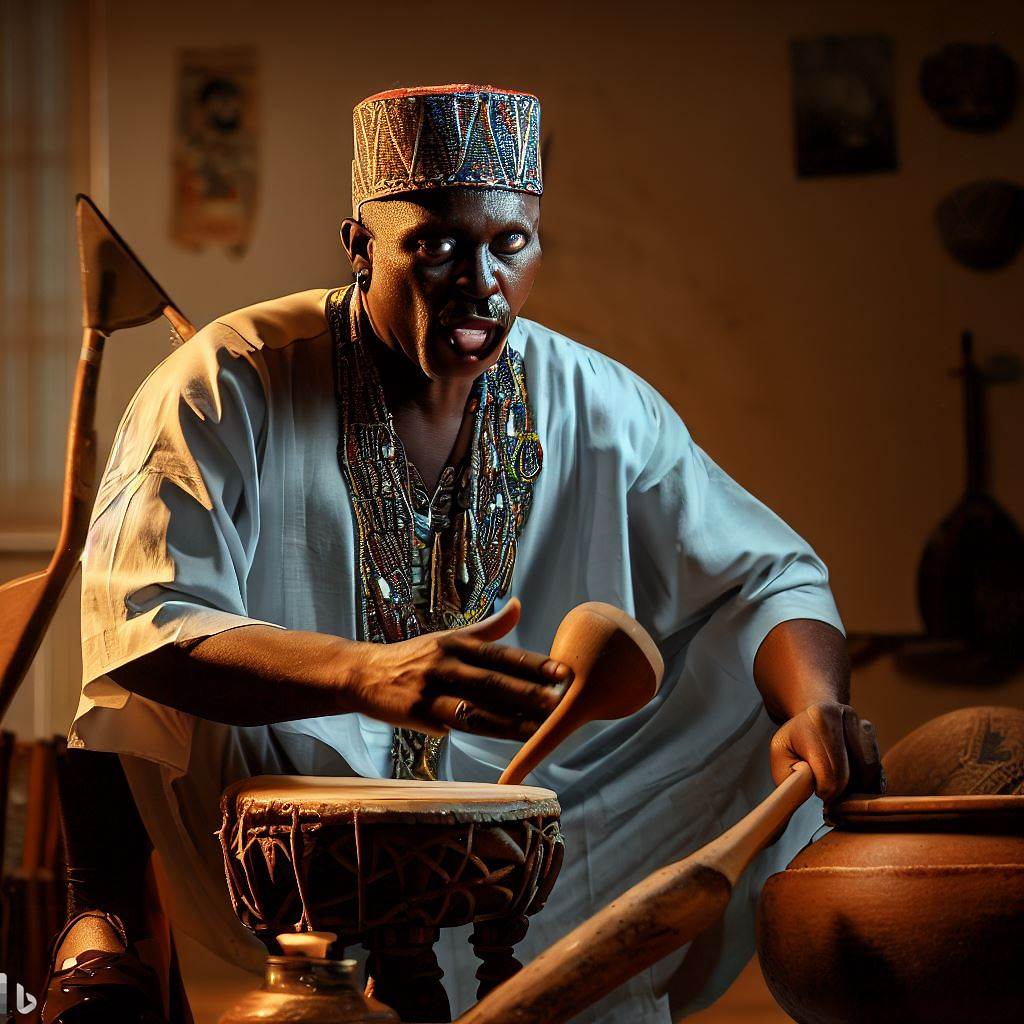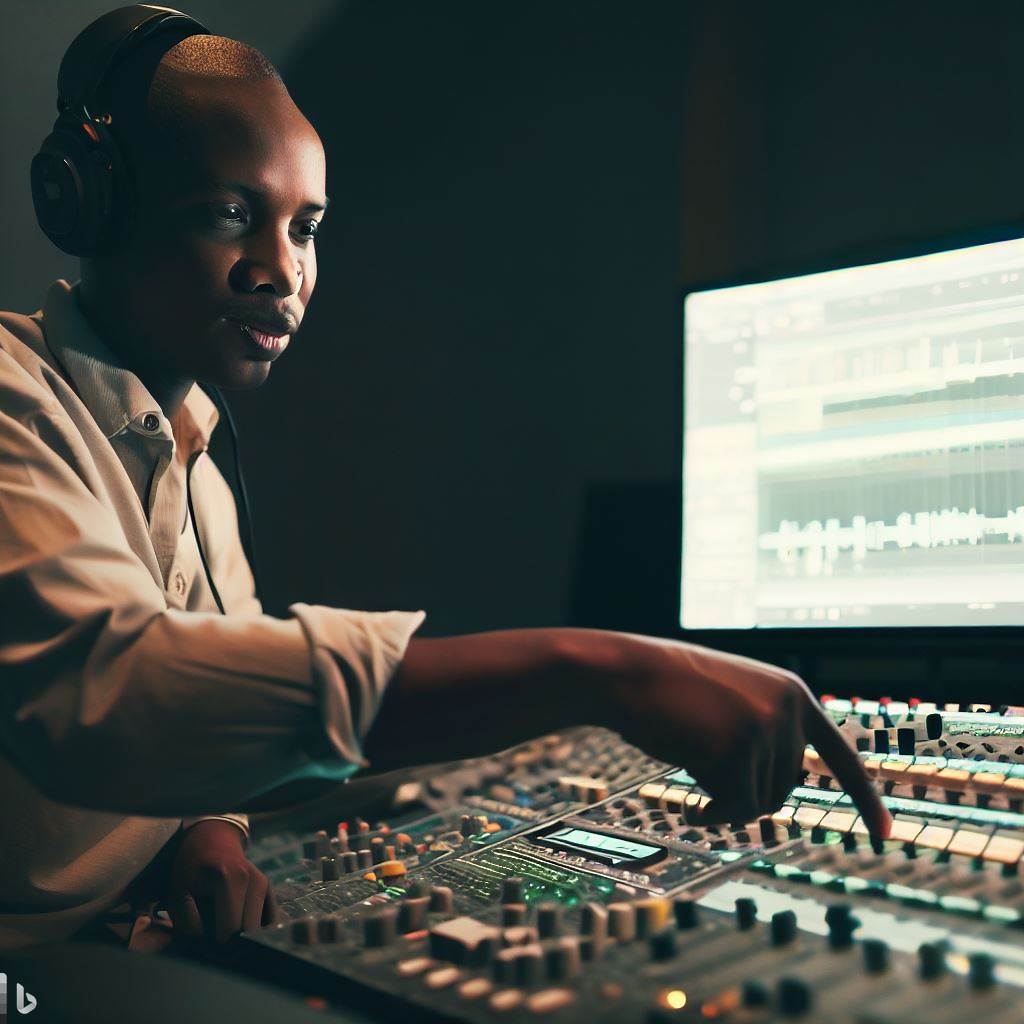Introduction
A Foley artist is a sound designer who creates and records everyday sounds for films and television.
A Nigerian Foley artist brings a unique perspective to this craft, incorporating local sounds and traditions.
Meet Foley artists, the creative wizards crafting lifelike sound effects for film. Dive into the distinctive skills and cultural nuances that set Nigerian Foley artists apart.
This chapter delves into the captivating routine of a Nigerian Foley artist’s day.
- Artistic Preparation: Selecting props and materials to mimic real-life sounds accurately.
- Scene Synchronization: Timing every effect to match actors’ movements, making sound seamless.
- Creative Mastery: Crafting unique sounds, from footsteps to weather elements, amplifying on-screen authenticity.
- Collaborative Magic: Foley artists work alongside sound engineers and directors to ensure auditory harmony.
- Cinematic Enchantment: By merging sound and visual narratives, Nigerian Foley artists create immersive storytelling.
Unraveling the role and daily life of a Nigerian Foley artist showcases their invaluable contribution to cinematic artistry.
The purpose of this blog post is to give readers a detailed glimpse into the daily life of a Nigerian Foley artist.
What is Foley Art?
Foley art and its significance in film and media production
Foley art is the creation and recording of custom sound effects for film and media.
It plays a crucial role in enhancing the overall audio experience for viewers.
The role of a Foley artist in creating realistic audio effects
A Foley artist is responsible for using various objects and materials to recreate sounds that match the actions on screen.
They carefully synchronize their actions with the visuals to ensure the audio is realistic and believable.
The importance of Foley art in enhancing the viewer’s experience
Foley art is essential in bringing a film or TV show to life.
It adds depth and realism to the sound design, immersing viewers in the story and enhancing their emotional connection to the characters and scenes.
- Foley art creates a sense of authenticity by adding sounds that are not captured during the filming process. This attention to detail enhances the viewer’s suspension of disbelief.
- It helps to emphasize specific actions or elements in a scene, drawing the audience’s attention and enhancing the storytelling.
- Foley art contributes to the overall mood and atmosphere of a film. By creating sounds that reflect the setting and environment, it helps to transport viewers into the world of the story.
- It allows for creative interpretation and experimentation. Foley artists have the freedom to invent and experiment with different techniques and materials to achieve the desired audio effects.
- Foley art can also contribute to the narrative by providing audio cues that support character development or convey hidden meanings that might not be apparent visually.
- Foley art adds an additional layer of immersion to the viewing experience, making the film more engaging and memorable for the audience.
Foley art is a vital aspect of film and media production. It brings the visuals to life by creating and recording realistic audio effects.
By enhancing the viewer’s experience, Foley art contributes to the overall quality and impact of a film or TV show.
Read: Behind the Scenes: The Role of an Animation Director
The Journey to Becoming a Nigerian Foley Artist
Challenges and Opportunities Faced by Aspiring Foley Artists in Nigeria
- Limited Resources: Foley artists in Nigeria often struggle with a lack of proper equipment and facilities.
- Lack of Recognition: Many aspiring Foley artists face challenges in getting their work recognized and appreciated in the industry.
- Financial Constraints: Funding for Foley projects is often limited, making it difficult for aspiring artists to pursue their passion.
- Limited Training Programs: Unlike in other countries, Nigeria lacks specialized training programs for Foley art, limiting opportunities for aspiring artists.
- Low Job Security: Foley artists often face a lack of job security and struggle to find consistent work in Nigeria.
Training and Education Required for a Career in Foley Art
- Understanding Sound: Aspiring Foley artists must have a deep understanding of how sound works and how it can be manipulated to create desired effects.
- Learning Industry Standard Techniques: Training programs for Foley art focus on teaching artists industry standard techniques and practices.
- Familiarity with Equipment: Foley artists must be proficient in working with various tools and equipment, such as recording devices and different surfaces for creating sounds.
- Attention to Detail: Education for Foley art emphasizes the importance of paying attention to even the smallest details to create realistic and immersive sound effects.
- Collaboration Skills: Artists are taught how to work closely with directors, sound engineers, and other professionals in the filmmaking process.
Personal Stories and Interviews with Nigerian Foley Artists
- John’s Journey: John, a successful Nigerian Foley artist, shares his inspirational story of starting as an amateur and working his way up through dedication and persistence.
- Chiamaka’s Career Path: Chiamaka, a female Foley artist, talks about the challenges she faced in a male-dominated industry and how she overcame them to achieve her dreams.
- The Impact of Mentors: Various Nigerian Foley artists credit their mentors for guiding them and providing valuable insights into the industry.
- Balancing Passion and Practicality: Interviewees discuss the importance of finding a balance between pursuing their artistic passion and meeting the practical demands of the industry.
- Advice for Aspiring Foley Artists: Experienced Nigerian Foley artists offer advice and tips for those aspiring to pursue a career in the field, emphasizing the importance of dedication, continuous learning, and networking.
Aspiring Foley artists in Nigeria face numerous challenges but also have opportunities to carve out successful careers.
With the right training, education, and determination, they can overcome obstacles and make significant contributions to the Nigerian film industry.
Read: Essential Skills for a Successful Animation Director
A Typical Day in the Life of a Nigerian Foley Artist
Overview of the daily routine
A typical day in the life of a Nigerian Foley artist is filled with creativity, meticulous attention to detail, and a passion for bringing sounds to life in films and other projects.
The design and preparation phase of Foley art
1. Researching sounds
Foley artists spend time researching various sounds that they will recreate in their studio. This involves watching the footage and understanding the specific sounds needed for each scene.
2. Gathering props and equipment
Once the sounds have been identified, Foley artists gather the necessary props and equipment to create those sounds. This could include anything from footsteps to the clanging of silverware.
3. Creating or modifying sound-making devices
In some cases, Foley artists need to create or modify sound-making devices to achieve the desired sound effects. This may involve constructing custom-made props or modifying existing items.
The recording process
1. Breaking down the scenes
Before recording, Foley artists break down each scene and identify all the different sounds that need to be created. This helps them ensure that each sound is accurately produced.
2. Syncing actions on the screen with sound effects
During recording, Foley artists carefully sync their actions with the actions on the screen. This attention to detail is crucial to achieving a realistic and believable sound design.
3. Utilizing different techniques and tools for various sounds
Foley artists use a variety of techniques and tools to create different sounds. This may involve using different types of footwear for footsteps or employing unconventional objects to replicate unique sounds.
Explore the post-production phase
1. Editing and mixing the recorded sounds
After the recording is complete, Foley artists move into the post-production phase. They meticulously edit and mix the recorded sounds to ensure they blend seamlessly with the film or project.
2. Collaborating with sound designers and editors
Foley artists collaborate closely with sound designers and editors to ensure that their work aligns with the overall sound design of the film.
This collaboration helps create a cohesive and immersive auditory experience.
3. Finalizing the sound effects for the film or project
Once the editing and mixing are complete, Foley artists work with the sound design team to finalize the sound effects for the film or project.
This involves making any necessary adjustments and ensuring the effects enhance the overall audio experience.
A typical day in the life of a Nigerian Foley artist involves a meticulous and creative process that brings sounds to life.
From researching and gathering props to recording and editing, Foley artists play a crucial role in enhancing the auditory experience of films and other projects.
Their attention to detail and passion for sound design contribute to the magic of the final product.
Read: A Day in the Life of a Nigerian Animation Director

Challenges and Rewards of a Nigerian Foley Artist
Unique challenges faced by Nigerian Foley artists
- Limited resources and equipment: Nigerian Foley artists often face the challenge of working with limited resources and equipment.
Foley studios in Nigeria may not have the same state-of-the-art technology and equipment available in other parts of the world. - Lack of recognition and support in the industry: Nigerian Foley artists often struggle to gain recognition and support within the industry.
Their work may go unnoticed or undervalued, making it difficult for them to secure consistent projects and earn a stable income. - Cultural and societal expectations: Foley artists also face cultural and societal expectations that can hinder their creativity.
Traditional Nigerian culture may prioritize more conventional career paths, discouraging individuals from pursuing artistic professions like Foley art.
The rewards of the profession
- The fulfillment of enhancing the audience’s experience: One of the greatest rewards for Nigerian Foley artists is the satisfaction of enhancing the audience’s experience.
Their work helps create a more immersive and realistic audio environment, making films and TV shows more engaging for viewers. - The opportunity to showcase Nigeria’s talent and creativity: Nigerian Foley artists have the unique opportunity to showcase the country’s talent and creativity on an international stage.
Through their work, they contribute to the growing global recognition of Nigerian arts and culture. - Potential career growth and international recognition: Despite the challenges they face, Nigerian Foley artists have the potential for career growth and international recognition.
With determination and a strong portfolio, they can attract opportunities from both local and international film industries.
In summary, Nigerian Foley artists face significant challenges due to limited resources, lack of recognition, and cultural expectations.
However, the rewards of their profession include the fulfillment of enhancing audience experiences, the opportunity to showcase Nigeria’s talent, and potential career growth.
Despite the hurdles they encounter, these artists continue to contribute their unique abilities to the film industry, leaving a lasting impact on the audience and promoting Nigerian creativity and talent.
Read: Emerging Trends in Nigeria’s Animation Industry
Conclusion
Foley art plays a crucial role in film and media production by enhancing the auditory experience.
Through this exploration of the life of a Nigerian Foley artist, we have gained valuable insights into their craft and dedication.
A Nigerian foley artist’s role magnifies cinematic experiences, merging sound and visuals for immersive storytelling.
- Sound Artistry: Foley artists meticulously craft auditory elements, enhancing scenes and emotions.
- Collaboration Dynamics: Their synergy with filmmakers shapes realistic and captivating soundscapes.
- Attention to Detail: Every action’s sound adds depth, evoking relatable and evocative sensations.
- Audience Engagement: Foley artistry enriches audience immersion, intensifying on-screen connections.
- Artful Craft: Foley artists’ dedication contributes to Nigeria’s cinematic vibrancy, accentuating storytelling impact.
Immersed in creativity, Nigerian foley artists amplify visual narratives, showcasing the artistry within cinema’s audible dimensions.
Let us all appreciate the art of sound effects and support Nigerian Foley artists in their creative endeavors.




